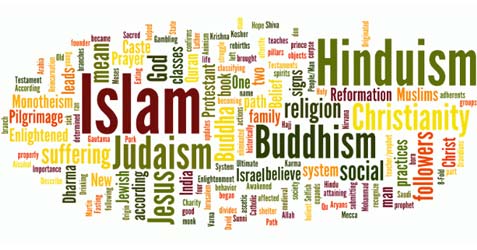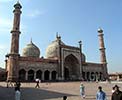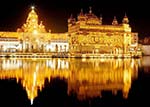


Throughout the Indian history, religion has been an important part of the country's culture. The vast majority of Indians associate themselves with a religion, and religious tolerance is reflected by the wide variety and numbers of different religions practiced in the nation.
Indian census has established that Hinduism accounts for 80% of the population of India. The second largest religion is Islam, at about 13% of the population. Other native Indian religions are Buddhism, Jainism, and Sikhism.
About 2% of Indians adhere to Christianity. Zoroastrianism and Judaism also have an ancient history in India and each has several thousand Indian adherents.
Indians are generally tolerant of other religions and retain a secular outlook. India's religious diversity extends to the highest levels of government. The Constitution of India declares the nation to be a secular republic that must uphold the right of citizens to freely worship and propagate any religion or faith (with activities subject to reasonable restrictions for the sake of morality, law and order, etc).

Even though the Bahai Faith in India is numerically small and tiny in proportion of the national population, it has a long history culminating in recent times with the notable Lotus Temple, various Bahai schools, and increasing prominence. The roots of the Bahai Faith in India go back to the first days of the Babi religion in 1844. After more than a century the Bahai Faith in India had only reached around 1,000 and for a significant time there hadn't even been an Indian-based community in India.

Buddhism is a world religion, which arose in Bihar, India and is based on the teachings of Siddhartha Gautama, who is known as the Buddha (literally the Enlightened One or Awakened One). The Mahabodhi Temple, a UNESCO World Heritage Site, is one of the four holy sites related to the life of the Lord Buddha, and particularly to the attainment of Enlightenment. The first temple was built by Emperor Asoka in the 3rd century BC, and the present temple dates from the 5th century or 6th century. It is one of the earliest Buddhist temples built entirely in brick, still standing in India, from the late Gupta period.

Christianity is India's third-largest religion, with approximately 24 million followers, constituting 2.4% of India's population. Most of the Christians in India are converted from Hinduism or Islam. Today Christians are found all across India and in all walks of life, with major populations in parts of South India, the Konkan Coast and the North-East. The Se Cathedral of Santa Catarina is a cathedral dedicated to Catherine of Alexandria, located in Old Goa.

India is the birthplace of Hinduism. The word Hindu is derived from the word Sindhu and signifies a person coming from the land of the river Sindhu (i.e. India). The name Sindhu is what the Hindus called the Indus River. India is the home to the largest number of Hindus. Hinduism has origins of around 2500 B.C. Presently there are around 930 million Hindus living in India and several million Hindus of Indian origin living abroad. Akshardham Temple, located at Delhi is the largest Hindu temple in the world.

Islam is India's second-most practiced religion after Hinduism, with more than 154 million followers , constituting 13.4% of the country's population identifying themselves as Muslims. India's Muslim population is the world's second largest and the world's largest Muslim-minority population. The first Indian mosque was built in 629 A.D., at the behest of Cheraman Perumal, during the life time of Muhammad (571–632) in Kodungallur by Malik Bin Deenar. Jama Masjid, in Delhi, is one of the largest mosques in Asia-Pacific region.

Jainism is considered as a legally distinct religion in India. There are 5,200,000 Jain in the 1.028 billion population of India. Jains are to be found in 34 out of 35 states and union territories with Lakshdweep being the only union territory without Jains. The state of Jharkhand is the birthplace of Jainism. Palitana Temples, located 50 km South-West of Bhavnagar city and is a major pilgrimage centre for Jains. There are more than 1300 temples located on the Shatrunjaya hills, exquisitely carved in marble. The main temple on top of the hill, is dedicated to 1st tirthankar lord Adinath (Rishabdeva).

Indian Jews are a religious minority of India. Judaism was one of the first non-Dharmic religions to arrive in India in recorded history. The better-established ancient communities have assimilated a large number of local traditions through cultural diffusion. The Jewish population in India is hard to estimate since each Jewish community is distinct with different origins. The Paradesi Synagogue is the oldest synagogue in the Commonwealth of Nations, located in Kochi, Kerala, in South India. It was built in 1568 by the Malabar Yehudan people or Cochin Jewish community in the Kingdom of Cochin.

Sikhism has been in India for over 500 years, beginning with the birth of its founder Guru Nanak Dev. About 2% of India's population are Sikhs. Traditionally the men keep their hair and do not shave their beard or moustache. They gather their head hair in a turban. In order to make it easier for his followers to recognize each other, Guru Gobind Singh, chose five marks, popularly known as the "5 K's". The five signs were, Kesh (uncut hair); Kara (bracelet on the right hand wrist); Kanga (comb); Kaccha (shorts) and Kirpan (sword or dagger).

Zoroastrianism is the religion and philosophy based on the teachings ascribed to the prophet Zoroaster, after whom the religion is named. The term Zoroastrianism is, in general usage, essentially synonymous with Mazdaism, i.e. the worship of Ahura Mazda, exalted by Zoroaster as the supreme divine authority. Faravahar (or Ferohar), is one of the primary symbols of Zoroastrianism, believed to be the depiction of a Fravashi (guardian spirit).